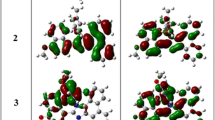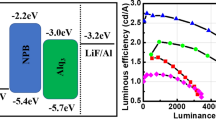Abstract
Organic light-emitting diodes (OLEDs) play a key role in modern display devices and systems. A highly desirable material for fabricating OLEDs is tris(8-hydroxyquinoline)aluminum (Alq3). In this work, a highly efficient OLED based on dysprosium (Dy)-incorporated Alq3 (Alq3-Dy) was fabricated. The fabricated OLED had four layers, namely, those of indium tin oxide (ITO), N, N′-Di(1-naphthyl)-N, N′-diphenyl-(1,1′-biphenyl)-4,4′-diamine (NPB), Alq3-Dy, and aluminum (Al). The ITO and Al layers were used as electrodes, while the NPB was selected as a hole transport layer. All the layers were deposited sequentially on a glass substrate. The surface morphologies of these layers clarified that the materials were deposited as nanosphere particles. The OLED performance showed significant improvement in terms of the operating voltage, current efficiency, and luminance of the fabricated Alq3-Dy OLED compared with that of the pure Alq3 OLED device. The luminance value was significantly enhanced from approximately 250 cd/m2 for the pure Alq3 OLED to approximately 5000 cd/m2 for the Alq3-Dy OLED. Moreover, the electroluminescence (EL) intensity of the Alq3-Dy OLED was 20 times higher than that of the Alq3 OLED. These findings may have a significant impact on the fabrication of the OLEDs and display devices.





Similar content being viewed by others
References
A.V. Sánchez-Mendoza, V.G. Ibarra-García, J.R. Velázquez-Hernández, O.J. Hernández-Ortíz, J. Carrillo, L. Palacios-Huerta, I. Cosme, A. Alvarez-Hernandez, K. Alemán-Ayala, R.A. Vázquez-García, Synthesis, chemical, theoretical studies, electrochemical, electrical and optical characterization of novel oligomer 2,2’-((1E,1’E)(2,5-bis(octyloxy)-1,4-phenylenevinylene)bis(6-(E)-2-(vinylquinolin))quinoline for OLED applications. J. Mater. Sci. 30(22), 19718–19730 (2019). https://doi.org/10.1007/s10854-019-02322-9
G.A. Sosa-Ortiz, V. Álvarez-Venicio, J.O. Guerra-Pulido, V.M. Velazquez-Aguilar, V.A. Basiuk, M.D.P. Carreón-Castro, Fabrication and characterization of an organic light-emitting diode based on Langmuir-Blodgett films using oligo(phenylenevinylene) derivatives. J. Mater. Sci. 31(1), 337–346 (2020). https://doi.org/10.1007/s10854-019-02527-y
Q. Dong, F. Tai, H. Lian, B. Zhao, Z. Zhong, Z. Chen, J. Tang, F. Zhu, Realization of efficient light out-coupling in organic light-emitting diodes with surface carbon-coated magnetic alloy nanoparticles. Nanoscale 9(8), 2875–2882 (2017). https://doi.org/10.1039/C6NR09769C
L. He, J. Liu, Z. Wu, D. Wang, S. Liang, X. Zhang, B. Jiao, D. Wang, X. Hou, Solution-processed small molecule thin films and their light-emitting devices. Thin Solid Films 518(14), 3886–3890 (2010). https://doi.org/10.1016/j.tsf.2009.11.002
Z. Wang, Z. Chen, Z. Lan, X. Zhai, W. Du, Q. Gong, Enhancement of Alq3 fluorescence by nanotextured silver films deposited on porous alumina substrates. Appl. Phys. Lett. 90(15), 151119 (2007). https://doi.org/10.1063/1.2722231
J.S. Jung, J.W. Lee, M.R. Seo, H.S. Lee, J. Kim, S.W. Lee, J. Joo, Luminescence variation of organic Alq3 nanoparticles on surface of Au nanoparticles and graphene. Synth. Met. 162(21), 1852–1857 (2012). https://doi.org/10.1016/j.synthmet.2012.08.005
D.-J. Jan, S.-S. Wang, S.-J. Tang, K.-Y. Lin, J.-J. Yang, J.-L. Shen, K.-C. Chiu, Growth and characterization of tris(8-hydroxyquinoline)-aluminum molecular films. Thin Solid Films 520(3), 1005–1009 (2011). https://doi.org/10.1016/j.tsf.2011.08.005
M.C. Tam, H. Su, K.S. Wong, X. Zhu, H.S. Kwok, Surface-plasmon-enhanced photoluminescence from metal-capped Alq3 thin films. Appl. Phys. Lett. 95(5), 051503 (2009). https://doi.org/10.1063/1.3190501
Y. Kajiyama, K. Kajiyama, H. Aziz, Diffusion barriers for achieving controlled concentrations of luminescent dopants via diffusion for mask-less RGB color patterning of organic light emitting devices. Opt. Express 23(24), 30783–30792 (2015). https://doi.org/10.1364/OE.23.030783
X. Duan, Y. Huang, Y. Cui, J. Wang, C.M. Lieber, Indium phosphide nanowires as building blocks for nanoscale electronic and optoelectronic devices. Nature 409(6816), 66–69 (2001). https://doi.org/10.1038/35051047
S. Fan, M.G. Chapline, N.R. Franklin, T.W. Tombler, A.M. Cassell, H. Dai, Self-oriented regular arrays of carbon nanotubes and their field emission properties. Science 283(5401), 512 (1999). https://doi.org/10.1126/science.283.5401.512
B.W. D’Andrade, S.R. Forrest, White organic light-emitting devices for solid-state lighting. Adv. Mater. 16(18), 1585–1595 (2004). https://doi.org/10.1002/adma.200400684
A.C. Grimsdale, K. Leok Chan, R.E. Martin, P.G. Jokisz, A.B. Holmes, Synthesis of light-emitting conjugated polymers for applications in electroluminescent devices. Chem. Rev. 109(3), 897–1091 (2009). https://doi.org/10.1021/cr000013v
J. Tagare, D.K. Dubey, R.A.K. Yadav, J.-H. Jou, S. Vaidyanathan, Triphenylamine-imidazole-based luminophores for deep-blue organic light-emitting diodes: experimental and theoretical investigations. Mater. Adv. 1(4), 666–679 (2020). https://doi.org/10.1039/D0MA00007H
H. Peng, Z. Wei, L. Wu, X. Li, Efficient non-doped blue fluorescent OLEDs based on bipolar phenanthroimidazole-triphenylamine derivatives. Opt. Mater. 101, 109726 (2020). https://doi.org/10.1016/j.optmat.2020.109726
J. Tagare, S. Vaidyanathan, Recent development of phenanthroimidazole-based fluorophores for blue organic light-emitting diodes (OLEDs): an overview. J. Mater. Chem. C 6(38), 10138–10173 (2018). https://doi.org/10.1039/C8TC03689F
C. Cui, D.H. Park, J. Kim, J. Joo, D.J. Ahn, Oligonucleotide assisted light-emitting Alq3 microrods: energy transfer effect with fluorescent dyes. Chem. Commun. 49(47), 5360–5362 (2013). https://doi.org/10.1039/C3CC41255E
C.W. Tang, S.A. VanSlyke, C.H. Chen, Electroluminescence of doped organic thin films. J. Appl. Phys. 65(9), 3610–3616 (1989). https://doi.org/10.1063/1.343409
C.W. Tang, S.A. VanSlyke, Organic electroluminescent diodes. Appl. Phys. Lett. 51(12), 913–915 (1987). https://doi.org/10.1063/1.98799
P. Jiang, W. Zhu, Z. Gan, W. Huang, J. Li, H. Zeng, J. Shi, Electron transport properties of an ethanol-soluble AlQ3-based coordination polymer and its applications in OLED devices. J. Mater. Chem. 19(26), 4551–4556 (2009). https://doi.org/10.1039/B904389F
H.-I. Baek, H.-K. Lee, C. Lee, Enhancement of the OLED driving stability by introducing an LiF-mixed α-NPD hole-transport layer, SPIE2006
M.A. Mohd Sarjidan, S.H. Basri, W.H. Abd Majid, Fabrication and characterization of organic light-emitting diodes containing small molecules blends as emissive layer. Adv. Mater. Res. 795, 106–109 (2013). https://doi.org/10.4028/www.scientific.net/AMR.795.106
G. Dasi, R. Ramarajan, K. Thangaraju, Improved electron injection in spin coated Alq3 incorporated ZnO thin film in the device for solution processed OLEDs. AIP Conf. Proc. 1942(1), 060015 (2018). https://doi.org/10.1063/1.5028785
W.J. Lee, Y.K. Fang, H.-C. Chiang, S.F. Ting, S.F. Chen, W.R. Chang, C.Y. Lin, T.Y. Lin, W.D. Wang, S.C. Hou, J.-J. Ho, Improving turn on voltage and driving voltage of organic electroluminescent devices with nitrogen doped electron transporter. Solid-State Electron. 47(5), 927–929 (2003). https://doi.org/10.1016/S0038-1101(02)00393-3
P.-C. Kao, J.-H. Lin, J.-Y. Wang, C.-H. Yang, S.-H. Chen, Li2CO3 as an n-type dopant on Alq3-based organic light emitting devices. J. Appl. Phys. 109(9), 094505 (2011). https://doi.org/10.1063/1.3585767
N. Hai, Z. Bo, T. Xian-Zhong, Significant improvement of OLED efficiency and stability by doping both HTL and ETL with different dopant in heterojunction of polymer/small-molecules. Chin. Phys. 16(3), 730–734 (2007). https://doi.org/10.1088/1009-1963/16/3/028
G. Xie, Y. Meng, F. Wu, C. Tao, D. Zhang, M. Liu, Q. Xue, W. Chen, Y. Zhao, Very low turn-on voltage and high brightness tris-(8-hydroxyquinoline) aluminum-based organic light-emitting diodes with a MoOx p-doping layer. Appl. Phys. Lett. 92(9), 093305 (2008). https://doi.org/10.1063/1.2890490
N. Salah, S.S. Habib, Z.H. Khan, Highly luminescent material based on Alq3: Ag nanoparticles. J. Fluoresc. 23(5), 1031–1037 (2013). https://doi.org/10.1007/s10895-013-1230-x
N.A.J. Salah, SA), Memic, Adnan (Jeddah, SA), Al-ghamdi, Attieh A. (Jeddah, SA), Algarni, Sabah Eid (Jeddah, SA), Khan, Zishan H. (New Delhi, IN), Method of making doped Alq3 nanostructures with enhanced photoluminescence, KING ABDULAZIZ UNIVERSITY (Jeddah, SA), United States (2018)
N. Salah, S.S. Habib, Z.H. Khan, N.D. Alharbi, Synthesis and characterization of pure and Tb/Cu doped Alq3 nanostructures. J. Lumin. 143, 640–644 (2013). https://doi.org/10.1016/j.jlumin.2013.06.004
A.P. Pushkarev, V.A. Ilichev, A.A. Maleev, A.A. Fagin, A.N. Konev, A.F. Shestakov, R.V. Rumyantzev, G.K. Fukin, M.N. Bochkarev, Electroluminescent properties of lanthanide pentafluorophenolates. J. Mater. Chem. C 2(8), 1532–1538 (2014). https://doi.org/10.1039/C3TC32054E
K. Walzer, B. Männig, M. Pfeiffer, K. Leo, Highly efficient organic devices based on electrically doped transport layers. Chem. Rev. 107(4), 1233–1271 (2007). https://doi.org/10.1021/cr050156n
L. Xiao, Z. Chen, B. Qu, J. Luo, S. Kong, Q. Gong, J. Kido, Recent progresses on materials for electrophosphorescent organic light-emitting devices. Adv. Mater. 23(8), 926–952 (2011). https://doi.org/10.1002/adma.201003128
J.C.G. Bünzli, Lanthanide luminescence for biomedical analyses and imaging. Chem. Rev. 110(5), 2729–2755 (2010). https://doi.org/10.1021/cr900362e
K. Binnemans, Lanthanide-based luminescent hybrid materials. Chem. Rev. 109(9), 4283–4374 (2009). https://doi.org/10.1021/cr8003983
P. Dai, J. Lu, M. Tan, Q. Wang, Y. Wu, L. Ji, L. Bian, S. Lu, H. Yang, Transparent conducting indium-tin-oxide (ITO) film as full front electrode in III–V compound solar cell. Chin. Phys. B 26(3), 037305 (2017). https://doi.org/10.1088/1674-1056/26/3/037305
M. Cuba, G. Muralidharan, Effect of thermal annealing on the structural and optical properties of tris-(8-hydroxyquinoline)aluminum(III) (Alq3) films. Luminescence 30(3), 352–357 (2015). https://doi.org/10.1002/bio.2738
K. Narayan, S. Varadharajaperumal, G.M. Rao, M.M. Varma, T. Srinivas, Effect of thickness variation of hole injection and hole blocking layers on the performance of fluorescent green organic light emitting diodes. Curr. Appl. Phys. 13(1), 18–25 (2013). https://doi.org/10.1016/j.cap.2012.06.004
S. Höfle, T. Lutz, A. Egel, F. Nickel, S.W. Kettlitz, G. Gomard, U. Lemmer, A. Colsmann, Influence of the emission layer thickness on the optoelectronic properties of solution processed organic light-emitting diodes. ACS Photon. 1(10), 968–973 (2014). https://doi.org/10.1021/ph500186m
S. Zeng, D. Baillargeat, H.-P. Ho, K.-T. Yong, Nanomaterials enhanced surface plasmon resonance for biological and chemical sensing applications. Chem. Soc. Rev. 43(10), 3426–3452 (2014). https://doi.org/10.1039/C3CS60479A
K.L. Kelly, E. Coronado, L.L. Zhao, G.C. Schatz, The optical properties of metal nanoparticles: the influence of size, shape, and dielectric environment. J Phys. Chem. B 107(3), 668–677 (2003). https://doi.org/10.1021/jp026731y
W.L. Barnes, A. Dereux, T.W. Ebbesen, Surface plasmon subwavelength optics. Nature 424(6950), 824–830 (2003). https://doi.org/10.1038/nature01937
K. Togashi, S. Nomura, N. Yokoyama, T. Yasuda, C. Adachi, Low driving voltage characteristics of triphenylene derivatives as electron transport materials in organic light-emitting diodes. J. Mater. Chem. 22(38), 20689–20695 (2012). https://doi.org/10.1039/C2JM33669C
M.-K. Kwon, J.-Y. Kim, B.-H. Kim, I.-K. Park, C.-Y. Cho, C.C. Byeon, S.-J. Park, Surface-plasmon-enhanced light-emitting diodes. Adv. Mater. 20(7), 1253–1257 (2008). https://doi.org/10.1002/adma.200701130
D.-D. Zhang, R. Wang, Y.-Y. Ma, H.-X. Wei, Q.-D. Ou, Q.-K. Wang, L. Zhou, S.-T. Lee, Y.-Q. Li, J.-X. Tang, Realizing both improved luminance and stability in organic light-emitting devices based on a solution-processed inter-layer composed of MoOX and Au nanoparticles mixture. Org. Electron. 15(4), 961–967 (2014). https://doi.org/10.1016/j.orgel.2014.02.007
S.T. Kochuveedu, D.H. Kim, Surface plasmon resonance mediated photoluminescence properties of nanostructured multicomponent fluorophore systems. Nanoscale 6(10), 4966–4984 (2014). https://doi.org/10.1039/C4NR00241E
S. Lambright, E. Butaeva, N. Razgoniaeva, T. Hopkins, B. Smith, D. Perera, J. Corbin, E. Khon, R. Thomas, P. Moroz, A. Mereshchenko, A. Tarnovsky, M. Zamkov, Enhanced lifetime of excitons in nonepitaxial Au/CdS core/shell nanocrystals. ACS Nano 8(1), 352–361 (2014). https://doi.org/10.1021/nn404264w
T. Ming, H. Chen, R. Jiang, Q. Li, J. Wang, Plasmon-controlled fluorescence: beyond the intensity enhancement. J. Phys. Chem. Lett. 3(2), 191–202 (2012). https://doi.org/10.1021/jz201392k
Acknowledgements
The authors in this project are very thankful for the Research & Consulting Institute at King Abdulaziz University, Jeddah, for their financial support under grant number M(MBD(08/017)).
Author information
Authors and Affiliations
Corresponding author
Additional information
Publisher's Note
Springer Nature remains neutral with regard to jurisdictional claims in published maps and institutional affiliations.
Electronic supplementary material
Below is the link to the electronic supplementary material.
Rights and permissions
About this article
Cite this article
Saeed, A., Alshahrie, A. & Salah, N. Fabrication of highly efficient organic light-emitting diode based on dysprosium-incorporated tris-(8-hydroxyquinoline)aluminum. J Mater Sci: Mater Electron 31, 22179–22189 (2020). https://doi.org/10.1007/s10854-020-04721-9
Received:
Accepted:
Published:
Issue Date:
DOI: https://doi.org/10.1007/s10854-020-04721-9




